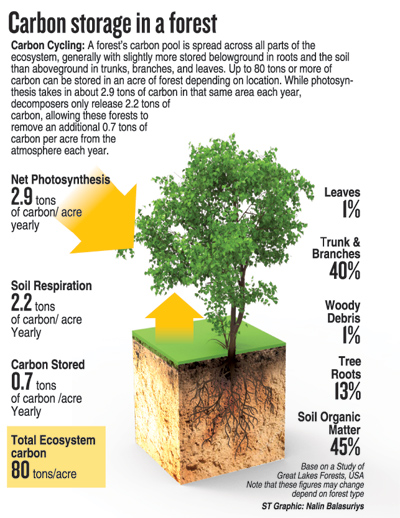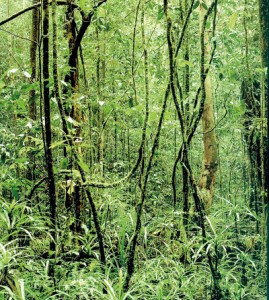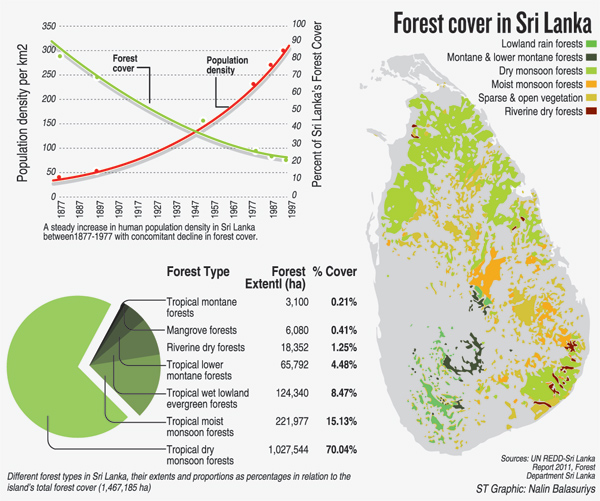News
President’s tree-planting programme hopes to avoid mistakes of past
President Maithripala Sirisena’s wish to increase Sri Lanka’s forest cover to 32 per cent from the current 29 per cent has been welcomed by environmentalists who point out that Sri Lanka has been steadily losing its forest cover.

Next week sees the end of National Tree Planting Month declared by the Ministry of the Environment, setting different themes for each week. The concluding week focuses on creative and sustainable planting.
President Sirisena this month announced Wana Ropa (planting of forest), a three-year program to increase forest cover to a third of the country’s land area, would begin in January next year.
It will accompany Punarudaya (renaissance), a larger program to drive sustainable development. Forest resources have rapidly been destroyed during the past few decades by racketeers who made their profits while destroying the environment.
It is everyone’s responsibility to protect natural resources and strict laws will be enforced against those who destroy them, President Sirisena said.
Environmentalists hope more will come from this tree-planting programme than from previous initiatives.
Tree-planting programs have been one of the most common environmental activities, and over the last few decades millions of samplings have been planted.
If only half of these plants survived the country would surely be much greener, environmentalists point out.
| Frontline of global warming fight Forests fight climate change by trapping the carbon component of carbon dioxide, a major culprit of global warming. Forests store carbon through photosynthesis, in which they take in atmospheric carbon dioxide and convert it into sugar-trapping carbon components. The sugar feeds the plant and helps it create new branches and leaves. Trees also “breathe out” carbon dioxide but particularly during the growth stage they store more carbon than they give out. When trees are cut down most of the trapped carbon is released into the atmosphere, increasing global warming. Sri Lanka is part of a global initiative on Reducing Emissions from Deforestation and forest Degradation (REDD) in developing countries, launched in 2008. |
The new program will take a different approach to avoid the problems of the past where many planted trees have died through lack of care.

Sinharaja rainforest. Pic by Vimukthi Weeratunga
“Because of this issue, trees will be planted mostly in places where they can be looked after and there is enough space,” an official of the Environmental Ministry said.
A former head of the Botanical Department, Dr. Siril Wijesundara, advised members of the public taking part in Wana Ropa to do some planning.Sri Lanka has different floristic regions so it is important to select a relevant species of tree.
Prepare the earth for planting and select a plant that is at least 1m tall. There are many campaigns using small plants but it is better to select a plant that is ready to become established in the new environment, increasing its chances of survival.
Smaller plants tend to die quickly and also the bigger plants will remind us that they need some attention, Dr. Wijesundara commented.
Dr. Wijesundara also highlighted the importance of the need to think about the size of the grown tree.
“Think ahead and visualise what will happen when the tree grows.” He said. “There could be electricity lines or large structures, and the tree can cause disruption to these. Some trees are not suitable for sloping ground.
“It is also very important to look after the tree without ignoring it after it is planted. After all, you are the foster-parent of such plant, so look after it by regularly watering and fertilising it,” Dr. Wijesundra said.
People should train trees planted near human settlement by pruning unwanted branches.
| Why it’s vital to protect existing forests The most threatened forests in Sri Lanka are those that are important for our survival. The lowland rainforests such as Sinharaja and Kanneliya cover less than 2 per cent of the land area and montane (mountainous) forests such as Horton Plains and Hakgala are just 1 per cent – but about 80 per cent of Sri Lanka’s unique biodiversity is found only in these areas. These forests play the major role in regulating our climate and stabilising the water cycle. Large-scale agricultural and settlement schemes are the main causes of deforestation. The Sri Lanka Association for the Advancement of Science estimates the annual change in forest cover in 2000-2005 was about 29,800 ha, a deforestation rate of 1.5 per cent. A forest expert, Professor Nimal Gunathilake, points out that as much as 7 per cent of forests are degraded. The National Conservation Review (NCR), conducted in the late 1990s, emphasised the need to protect the remaining wet zone forests that have very high biodiversity but are becoming fragmented. Sadly, many of Sri Lanka’s protected forests are in the Dry Zone. Prof. Gunathilake pointed out the need of bringing Land Reclamation Commission (LRC) lands with wet zone forests under protection. Boundary demarcation disputes have slowed the process of getting them under the control of the Forest Department. Action is needed quickly because tea plantations in particular spread into these lands, Prof. Gunathilake said
|


 .
.